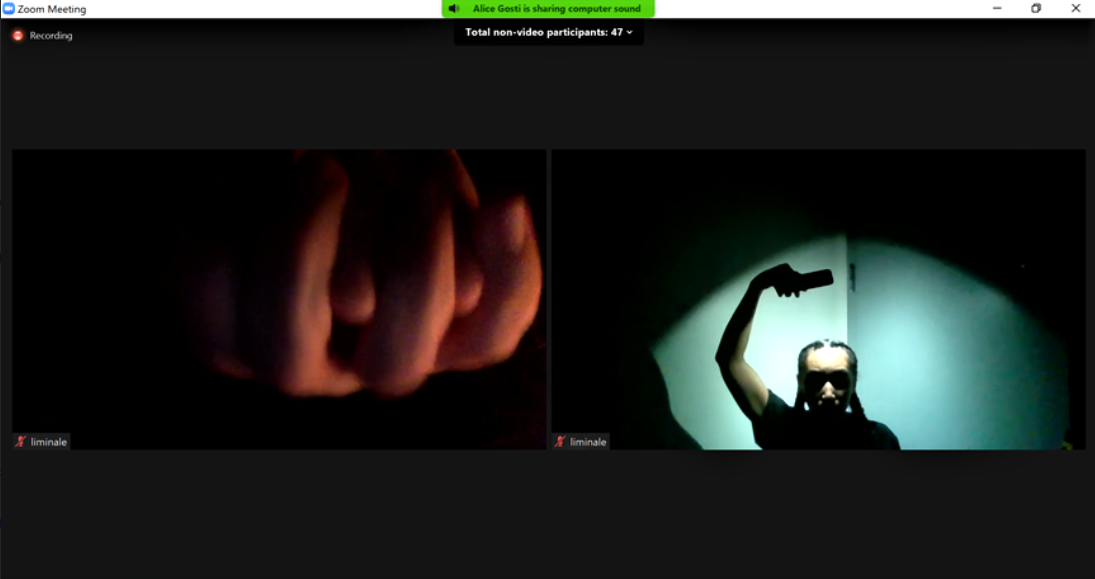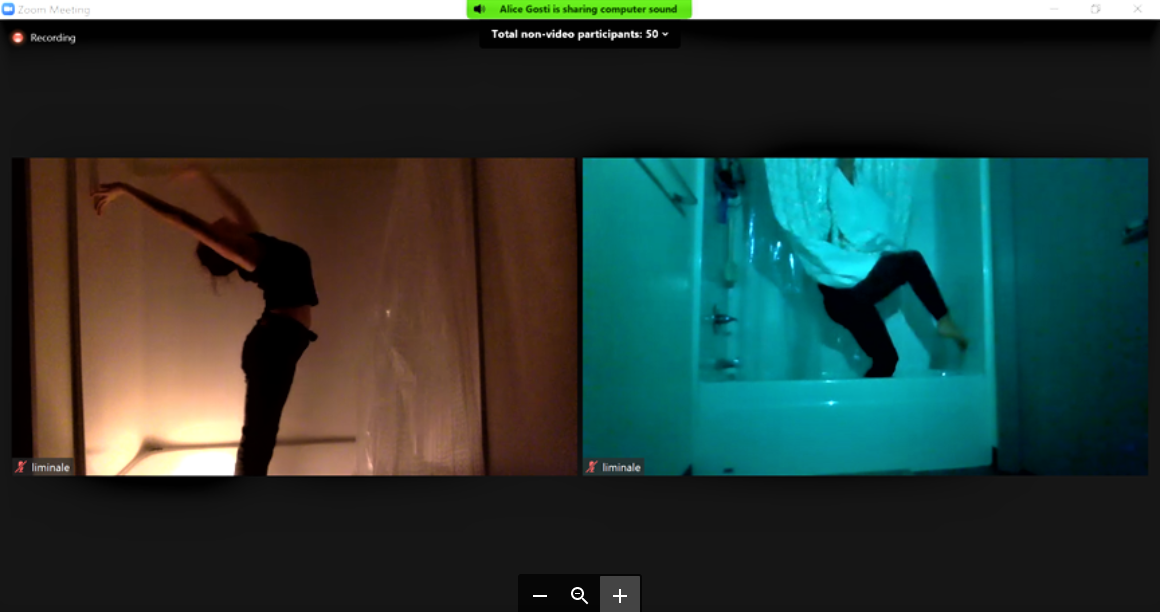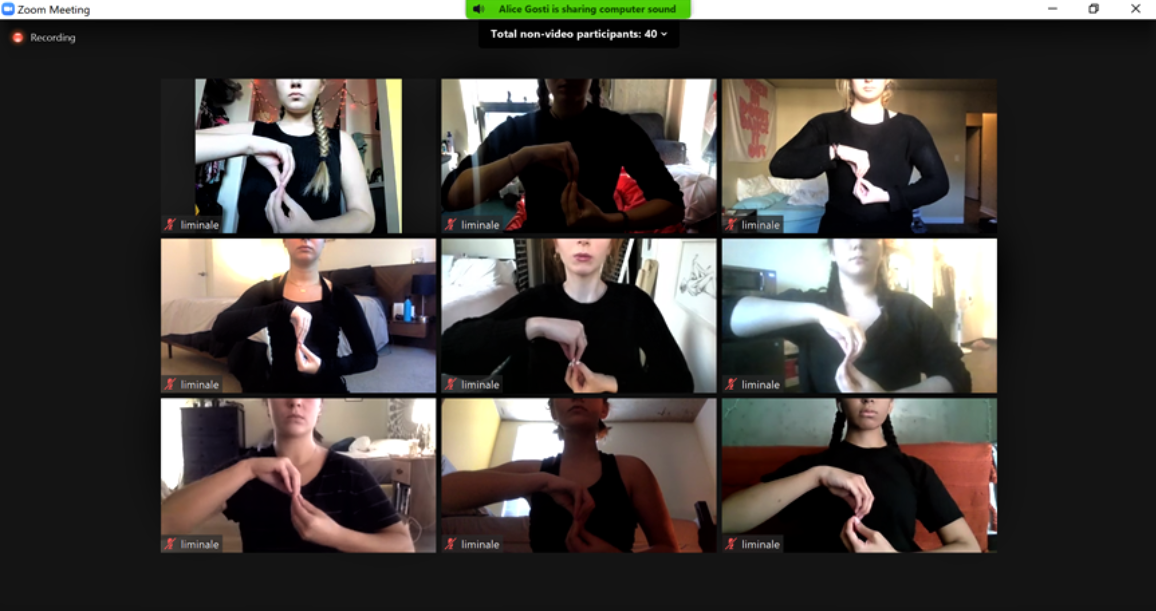Liminale: The Art of Transition and Resilience
Review of Liminale at Cornish College of the Arts
Written by Teen Writer Disha Cattamanchi and edited by Teen Editor Lucia McLaren

Even after eight months of a pandemic and the constant quarantine and mask protocols, the reality of COVID-19 and its predicaments has yet to set in for many. We are in a suspended limbo where events around the world pass through us like the wind, all left in our rooms peering at our computer screens for work or school. It’s exhausting, to say the very least, and without the reprieve of art or performance to look forward to, it seems even more hopeless. This very feeling of entrapment is thoughtfully explored through Liminale, a Zoom-adapted dance performance at the Cornish College of Arts, which escapes the boundaries of our homes as it transforms living spaces into a blank canvas. Performed by students Margaux Gex, Ashley Glen, Vivian Larsen, Lola Mahaney, Hannah Owens, Alexandra Pelzer, Kennedy Polovich, Madeleine Selby, Kristin Skelley, and Audrey Wright of Alice Gosti’s Dance 257-Creative Process for Remote Spaces, it utilizes the Zoom platform, altering our perceptions of proper creative spaces into something new and interesting in this transitional period of COVID-19.

Critically acclaimed and award-winning choreographer Alice Gosti sought to transform the boundaries of Zoom into new horizons by expanding the reach that dancers had in their own homes. As viewers, we experimented with Zoom’s multitude of features, switching back and forth between viewing the dancers through gallery or single speaker mode. It was interesting to play around with these features and to see where I wanted to focus my attention the most. I found that I liked the gallery more, as I could draw parallels on all the dancers and their synchronous movements all at once.
Throughout the course of the production, the dancers took us through the course of their daily lives. It started as they entered through their front doors, a synth soundtrack echoing behind them as they floated through their environments.
Their kitchens, beds, desks, and windows were used to give context to the dancers’ fluid movements as they floated from room to room and exhibited their talented gestures. Some performers were dancing on the walls, using it as their guide. Hand and shoulder movements were also exhibited on top of desks as dancers positioned cameras at varying angles to best showcase their work. They were jarring and unlike the fluid motions exhibited in other scenes. The more erratic motions showed unease and discontent, while the fluid motions displayed tranquility and calmness.

In a particularly eerie scene, dancers sat in various areas in their kitchens; from inside their sinks to sink cupboards. It was unusual that this was how the dancers were interacting with their kitchen spaces, but it made the scenes more captivating, as we saw their isolation and despair as they surrendered to the boundaries of their spaces. The performers also moved around in their spaces a lot, covering their cameras or taking us with them as they strategically moved through the spaces. This made the experience more intimate as we traveled through their homes.
Lighting was also creatively used in creating this production, all engineered by Gosti in collaboration with the dancers. Brightly lit windows were used to create silhouettes of the dancers that were striking to look at. One particular dancer was positioned in front of a brightly lit window and emphatically moved her arms and body in front of it, creating a visual contrast of light and darkness. Another dancer, who was in her bathroom tub, filled the room with a bright red light as the rest of the room was doused in darkness. The shadows she cast with her body as she danced were powerful, as parts of her limbs and body were starkly illuminated. The visuals of these particular scenes were stunning and made the transitions vary in depth and exposure.

Though this dance was viewed through Zoom, the actions of the dancers seemed limitless. I would much rather see dance in person on a stage, but this smartly crafted performance was enough to satisfy any dance-loving human. With the lighting, dance gestures, and space utilization, Liminale creatively transformed the dancers’ living spaces into that of an art exhibit. Most importantly, it showed us how art and dance can remain interesting through the use of different mediums such as Zoom. It depicts how art is transitional; all but a string of moments that utilize its environment for expression. The purpose is aptly described in the name of the production itself. “Liminale” is the Italian word for liminal, meaning transitional, or occupying at a boundary. True to its name, this production turned its boundaries into ways to expand its performance and showcased what dance looks like in this transitional time.
Liminale, a live Zoom dance performance, was presented by Cornish College of the Arts, on Sunday, November 8, 2020. For more information see here.
Lead photo credit: Liminale by Alice Gosti. Photo by Sarah Haskell
The TeenTix Newsroom is a group of teen writers led by the Teen Editorial Staff. For each review, Newsroom writers work individually with a teen editor to polish their writing for publication. The Teen Editorial Staff is made up of 6 teens who curate the review portion of the TeenTix blog. More information about the Teen Editorial Staff can be found HERE.
The TeenTix Press Corps promotes critical thinking, communication, and information literacy through criticism and journalism practice for teens. For more information about the Press Corps program see HERE.

